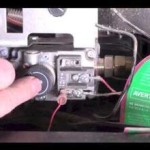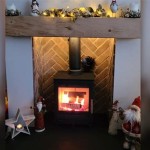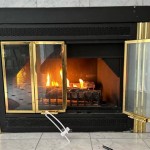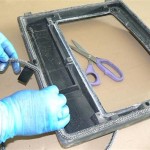Understanding Fireplace Logs for Gas Fireplaces
Gas fireplaces offer a convenient and often more environmentally friendly alternative to traditional wood-burning fireplaces. They provide instant warmth and ambiance without the mess and hassle of sourcing, storing, and burning wood. A crucial component of the aesthetic appeal of a gas fireplace is the set of artificial logs placed within the firebox. These logs are designed to mimic the appearance of natural wood, contributing significantly to the overall realistic look of the flame and fire.
The selection of appropriate fireplace logs for a gas fireplace is not merely about aesthetics. It is also about safety, performance, and compatibility with the specific type of gas fireplace. Using the wrong type of logs can lead to inefficient burning, damage to the fireplace unit, and even pose safety hazards. This article explores the various aspects of fireplace logs designed for gas fireplaces, providing a comprehensive understanding of their types, materials, considerations for selection, and maintenance.
Gas fireplace logs differ substantially from real wood logs. They are manufactured from materials that are resistant to the high temperatures produced by gas flames. These materials are also designed to distribute heat evenly and to withstand the corrosive effects of combustion gases. Furthermore, the logs are often painted with intricate details to resemble different types of wood, enhancing the visual realism of the fireplace.
Types of Gas Fireplace Logs
Gas fireplace logs are primarily categorized based on the materials used in their construction. The prevalent materials include ceramic fiber, refractory cement, and vermiculite. Each material offers unique properties in terms of heat resistance, durability, and aesthetic appearance. Understanding the characteristics of each type is essential for making an informed decision when choosing logs for a gas fireplace.
Ceramic Fiber Logs: Ceramic fiber logs are among the most common types available. They are manufactured from a blend of ceramic fibers and binders, resulting in a lightweight and porous material. This porosity allows for excellent heat transfer, enabling the logs to quickly radiate warmth into the surrounding room. Ceramic fiber logs are also relatively inexpensive compared to other types, making them a popular choice for many homeowners.
A significant advantage of ceramic fiber logs is their ability to withstand high temperatures without warping or cracking. They are also resistant to the corrosive effects of combustion gases, ensuring a long lifespan. The lightweight nature of ceramic fiber logs also makes them easy to handle and position within the fireplace. However, ceramic fiber logs tend to be more fragile than other types, and they can be susceptible to damage from impacts or rough handling. They also tend to be less realistic in appearance compared to logs made from other materials.
Refractory Cement Logs: Refractory cement logs are made from a dense, heat-resistant concrete mixture. This material provides exceptional durability and heat retention, making them an excellent choice for homeowners seeking a long-lasting and efficient log set. Refractory cement logs are heavier and more robust than ceramic fiber logs, making them less prone to damage. They also tend to have a more realistic appearance, with intricate details that closely mimic the look of natural wood.
The high density of refractory cement logs allows them to absorb and retain heat for a longer period, radiating warmth even after the gas flame is turned off. This can contribute to greater energy efficiency and lower heating bills. However, refractory cement logs are typically more expensive than ceramic fiber logs due to the higher cost of materials and manufacturing processes. Their weight can also make them more challenging to handle and position within the fireplace.
Vermiculite Logs: Vermiculite logs are crafted from expanded vermiculite, a mineral that is known for its excellent insulation properties. These logs are relatively lightweight and offer good heat distribution. They are often combined with other materials, such as ceramic fibers, to enhance their structural integrity and heat resistance. Vermiculite logs provide a balance between affordability, durability, and aesthetic appeal.
The porous nature of vermiculite allows for efficient heat transfer, enabling the logs to quickly warm up and radiate heat into the room. Vermiculite logs are also relatively resistant to cracking and warping, ensuring a long lifespan. They are often treated with a special coating to enhance their appearance and protect them from damage. While vermiculite logs may not be as realistic in appearance as refractory cement logs, they offer a cost-effective and practical option for many gas fireplace owners.
Factors to Consider When Selecting Gas Fireplace Logs
Choosing the right set of gas fireplace logs requires careful consideration of several factors, including fireplace size and type, burner style, aesthetic preferences, and budget constraints. Selecting logs that are properly sized and compatible with the fireplace unit is crucial for ensuring safe and efficient operation. Aesthetics are also key, as the logs contribute significantly to the overall visual appeal of the fireplace. Budget considerations will also play a role in determining the best option.
Fireplace Size and Type: The size and type of gas fireplace are critical factors in determining the appropriate log set. The logs must be sized correctly to fit within the firebox without obstructing the burner or interfering with the proper ventilation. Using logs that are too large can lead to incomplete combustion, resulting in the production of carbon monoxide and other harmful gases. It is vital to consult the fireplace manufacturer's specifications or a qualified technician to determine the recommended log size for the specific fireplace model.
Different types of gas fireplaces, such as vented and ventless models, require different types of log sets. Vented gas fireplaces require logs that are designed to work with a chimney or flue to vent combustion gases outside the home. Ventless gas fireplaces, on the other hand, are designed to burn cleanly enough to operate without a chimney. These fireplaces require specially designed logs that are certified for use in ventless systems. Using the wrong type of logs in a ventless gas fireplace can pose a significant safety risk.
Burner Style: The style of the gas burner also influences the selection of fireplace logs. There are several types of gas burners, including pan burners, pipe burners, and ribbon burners. Each type produces a different flame pattern, which affects the appearance of the fire and the distribution of heat. The logs should be arranged to complement the flame pattern and to maximize the visual realism of the fire.
For example, pan burners typically produce a wide, shallow flame, while pipe burners produce a taller, more concentrated flame. The logs should be positioned to accentuate the characteristics of each burner style. Some log sets are specifically designed to work with certain types of burners, and it is essential to choose logs that are compatible with the fireplace's burner style for optimal performance.
Aesthetic Preferences: The aesthetic appearance of the fireplace logs is a matter of personal preference. Gas fireplace logs are available in a wide range of styles, colors, and textures, designed to replicate different types of wood, such as oak, birch, and pine. Some logs are even painted with intricate details to mimic the look of charred or weathered wood. The logs should complement the overall decor of the room and reflect the homeowner's personal style.
Consider the color scheme of the room and the overall ambiance that is desired. Lighter-colored logs can create a bright and airy feel, while darker-colored logs can add warmth and sophistication. Consider also the arrangement of the logs. A natural-looking stack of logs will create a more realistic appearance than a perfectly symmetrical arrangement. The goal is to create a fire that is both visually appealing and inviting.
Budget Considerations: The cost of gas fireplace logs can vary significantly depending on the material, size, and detail of the log set. Ceramic fiber logs are generally the least expensive option, while refractory cement logs tend to be the most expensive. Vermiculite logs offer a middle ground in terms of cost and performance. It is essential to establish a budget before starting the selection process and to compare prices from different retailers.
Consider the long-term value of the log set. While a less expensive log set may seem appealing initially, it may not last as long or provide the same level of heat efficiency as a more expensive option. Investing in a high-quality log set can provide years of enjoyment and save money on heating bills in the long run.
Maintaining Gas Fireplace Logs
Proper maintenance is essential for ensuring the longevity and performance of gas fireplace logs. Regular cleaning and inspection can help to prevent damage and ensure that the logs continue to look their best. Following the manufacturer's recommendations for cleaning and maintenance is crucial for maintaining the warranty and avoiding potential safety hazards.
Cleaning: Over time, gas fireplace logs can accumulate soot and dust, which can diminish their appearance and affect their performance. Regular cleaning can help to remove these buildup and keep the logs looking their best. The cleaning process should be performed with care to avoid damaging the logs. Always ensure the fireplace is completely cool before attempting to clean the logs. Use a soft brush to gently remove loose soot and dust. For more stubborn stains, a mild detergent and water solution can be used. Avoid using harsh chemicals or abrasive cleaners, as these can damage the finish of the logs.
Inspection: Regular inspection of the gas fireplace logs is essential for identifying any signs of damage or wear. Check for cracks, chips, or warping. These issues can affect the performance of the logs and potentially pose a safety risk. If any damage is detected, it is important to replace the logs as soon as possible. Also, inspect the burner and gas lines for any signs of leaks or corrosion. Any issues with the burner or gas lines should be addressed by a qualified technician.
Placement: The placement of the logs within the fireplace is crucial for ensuring proper combustion and ventilation. Ensure that the logs are positioned according to the manufacturer's instructions. Do not stack the logs too tightly, as this can restrict airflow and lead to incomplete combustion. Also, make sure that the logs are not blocking the burner or any of the ventilation openings. The correct placement of the logs will ensure that the fireplace operates safely and efficiently.

Vented Gas Logs Heater Or Decorative Bart Fireside

The Best Gas Log Sets For 2024 Fireplaces Direct Learning Center

Napoleon Gl18e Vented Gas Log Set 18 Inch

What You Need To Know About Gas Fireplace Logs Fireplaces Direct Learning Center

Pleasant Hearth 18 Dual Fuel Wildwood Vent Free Gas Log Set 30 000 Bt

Gas Fireplace Log Bundle Woodstack 18 Harvest Exclusive Masters Services Chimney Sweep And Masonry

Vented Gas Logs Freeman

Majestic Vdy Duzy Series Vented Gas Log Set

Gas Logs Guide

Beautiful Gas Burning Fireplace Log Installations Buffalo Rochester Ny
Related Posts








